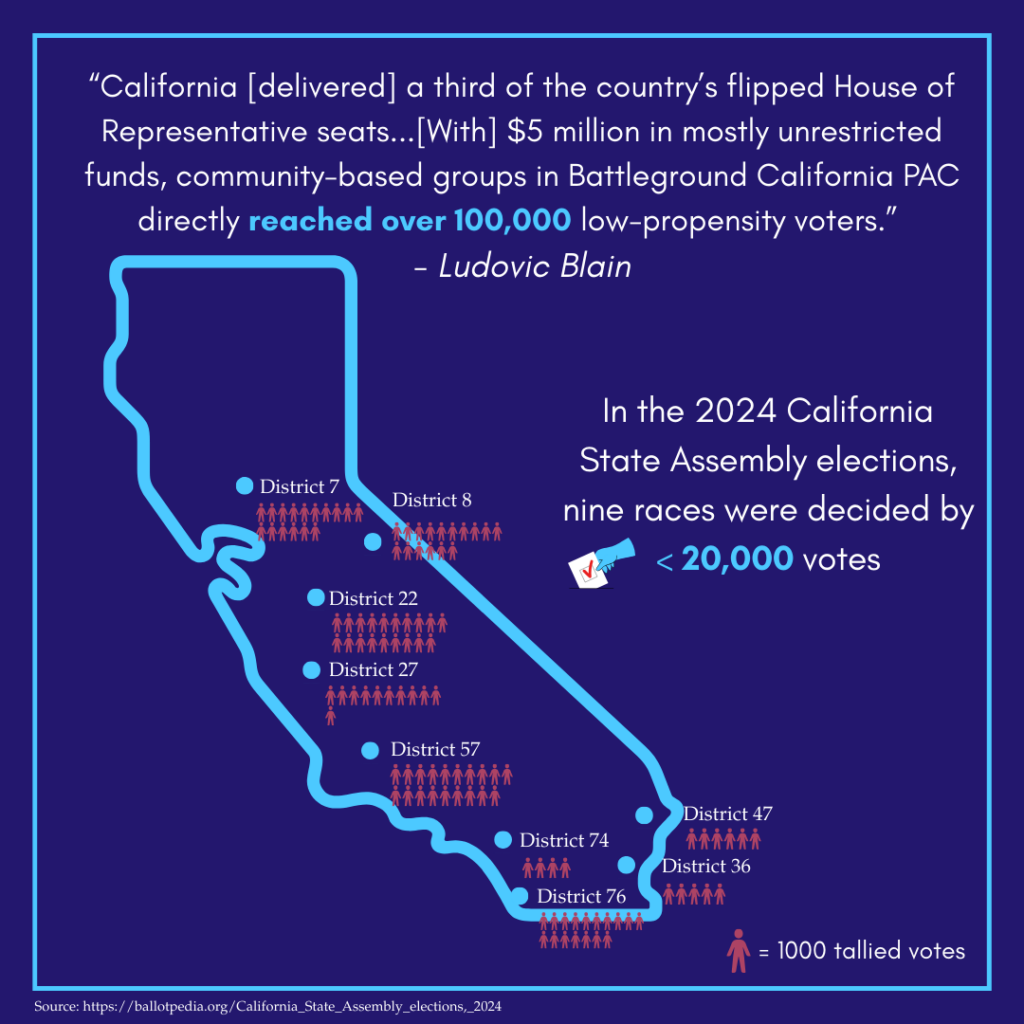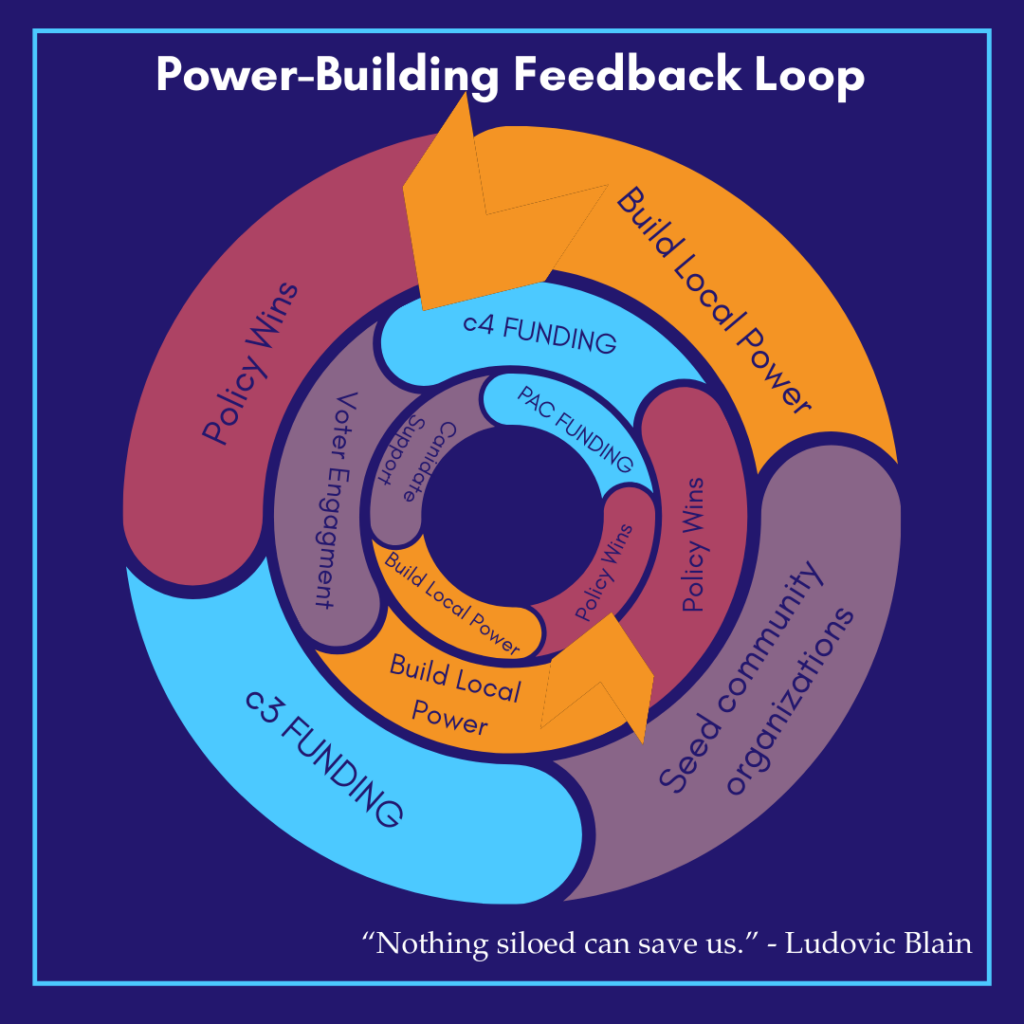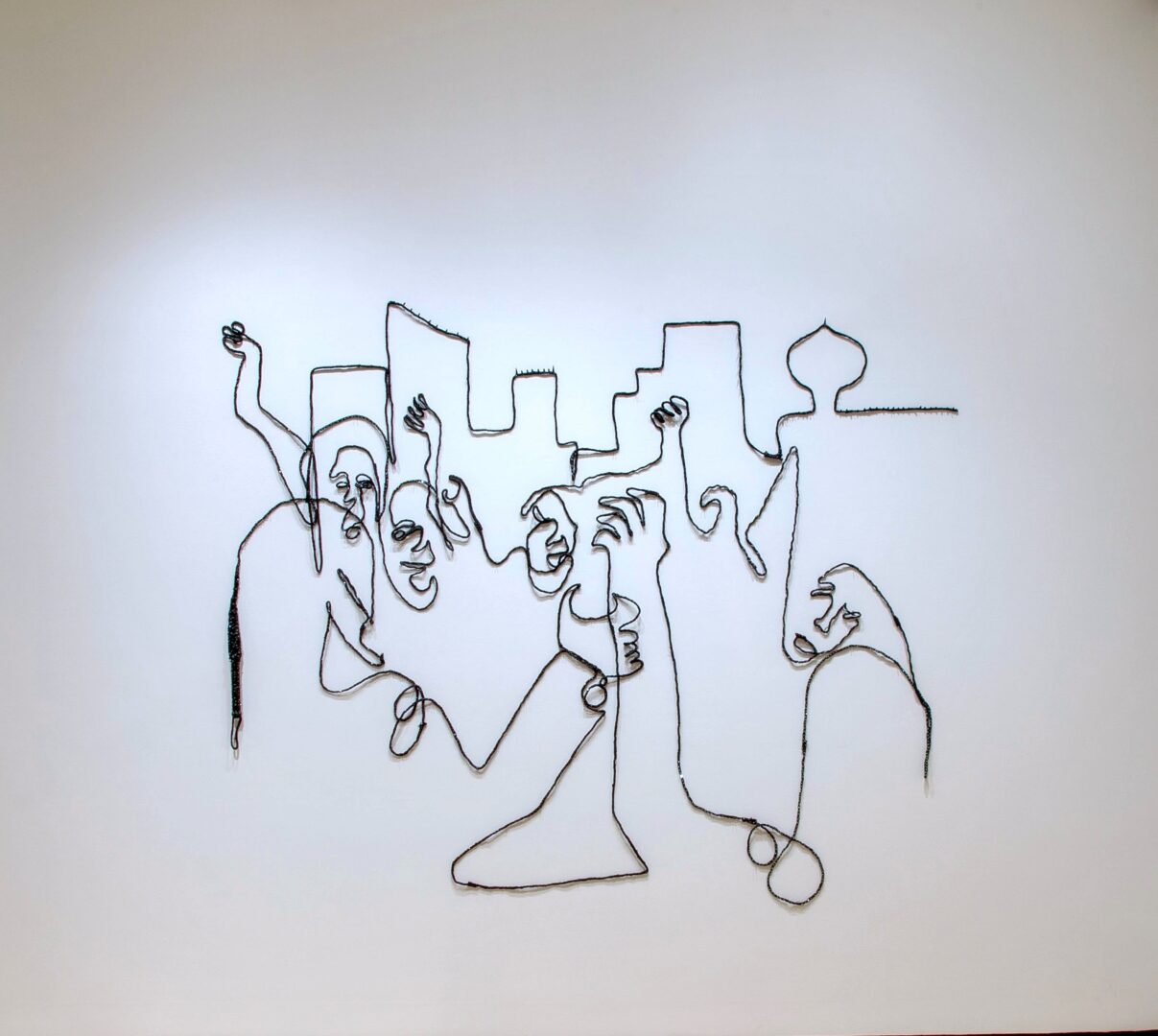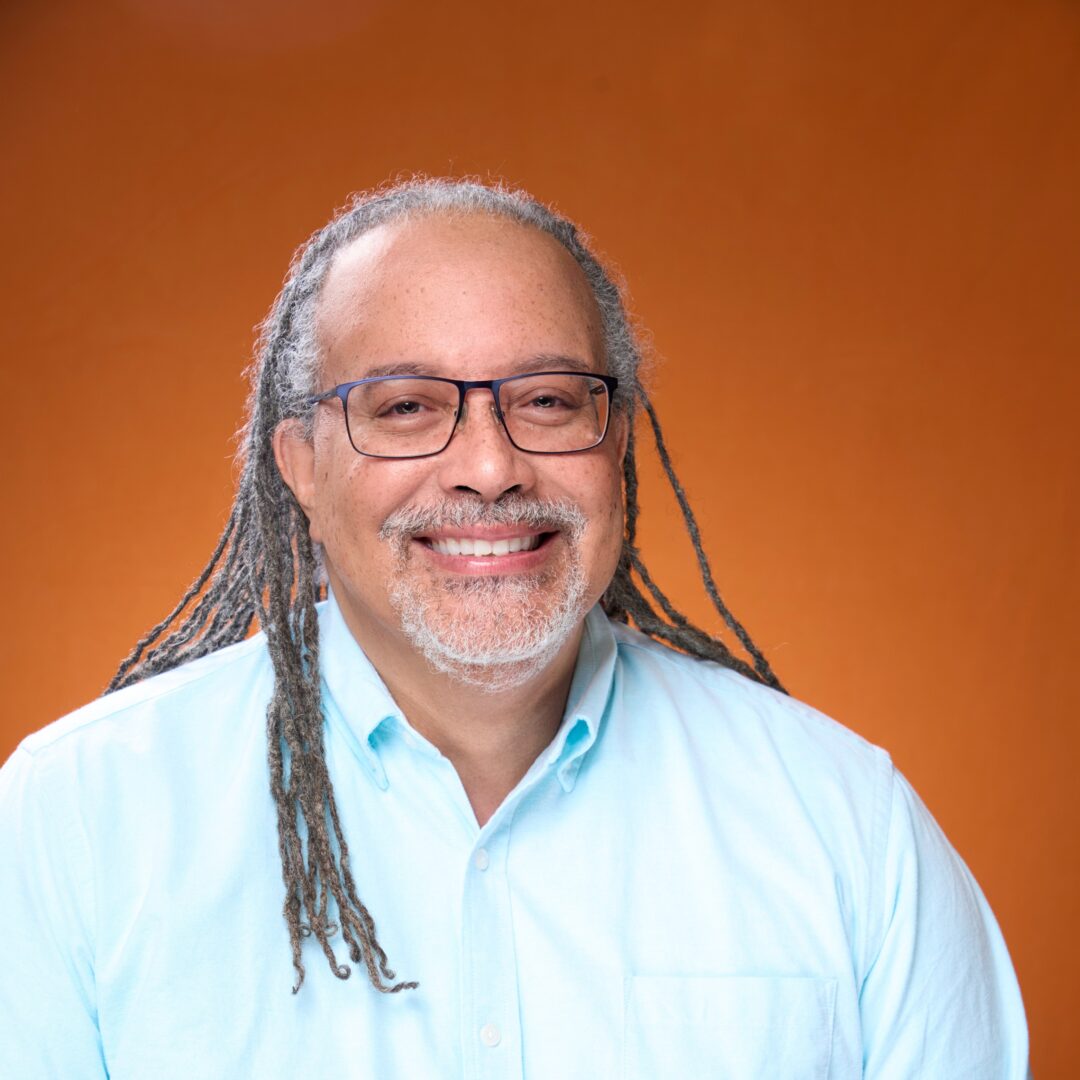There’s no question about it: nonpartisan organizations defending human rights, providing direct services, and uniting communities – along with funders who keep their staff paid – represent some of the strongest safeguards protecting vulnerable Americans in our increasingly authoritarian landscape. In addition to these organizations, we’re depending on a crucial set of politicians and policies to fight back. We all know that politicians and policymakers who are doing things because we are holding them accountable are not as effective as those who are actually aligned with us and doing those things based on their own values.
Too often, nonpartisan funders comfort themselves by saying “elections can’t save us.” By saying this we discredit the very real work that is being done. That the last 100+ days have not been improved by California Attorney General Rob Bonta and New York Attorney General Letitia James slowing Trump’s machinations down by suing him left and right, California Secretary of State Shirley Weber refuting Trump’s lies about voting systems, and Los Angeles Karen Bass pushing back on Trump. It’s not hard to imagine that incoming Oakland Mayor Barbara Lee will also be an important bulwark against looming fascism.
And if those examples don’t sway you, all of us who were disappointed at California Governor Newsom uncritically platforming fascists like Charlie Kirk or watching Michigan Governor Gretchen Whitmer and New York City Mayor Eric Adams acquiescing to Trump have certainly experienced the reality that elections do indeed make a difference.
The truth is: Nothing siloed can save us.

For the last 20 years, California Donor Table (CDT) has mobilized more than $60 million from individuals and foundations across all tax statuses – 501(c)(3), 501(c)(4), and PACs – and created a positive power-building feedback loop that’s turned Republican districts blue. Hundreds of successful initiatives powered by our grantee network of organizations, candidates, and elected officials culminated in one of the only federal bright spots of the 2024 election: California delivering a third of the country’s flipped House of Representative seats. Through co-founding Battleground California PAC with many of the (c)(4) affiliates of the community organizing groups we helped seed more than a decade ago, we ensured Democrats picked up 3 more seats in the House of Representatives and defended 1 vulnerable Democratic seat. With $5 million in mostly unrestricted funds, community-based groups in Battleground California PAC directly reached over 100,000 low-propensity voters. In 2026, California may have 10 to 11 swing districts – more than any state in the country, concentrated in the same 4 regions we’ve been investing in for decades. Here’s how collaborative multi-entity funding made this possible and how continued funding will guarantee more and more success.
A Donor (Social) Justice League Assembles
The 2010 Census revealed what we already knew: California crossed the threshold to becoming the country’s third new American majority state. But in San Diego, Central Valley, the Inland Empire and Orange County, where Black, Latino and Asian populations were exploding, voter turnout and political representation were completely mismatched.
With a shared interest in rebalancing governing power in California at regional, state, and federal levels to advance a people-centered democracy reflecting its population, 4 funders came together to see what could be achieved when they applied every funding vehicle available to a shared mission: A nonpartisan 501(c)(3) foundation, a donor adviser, a PAC connected to a donor, and the predecessor of CDT. We worked to align funding across tax statuses to establish an infrastructure we’re still utilizing today.
With all our chips on the table, we zeroed in on these 4 regions where demographic change was outpacing local infrastructure. Latino, Asian American and Pacific Islanders, and Black Californians who were getting priced out of Los Angeles were moving into new neighborhoods with no established networks to address shared social, economic, or political needs. As seasoned community organizers, we know voter turnout and political power depends on strong local organizing. With strong community infrastructure, a more inclusive democracy would follow.
We knew no single anchor organization could drive transformation alone. Like us on the funding side, progress would depend on strong, strategic practitioner coalitions. In San Diego, for example, rather than sink all our investments to the biggest game in town – the labor federation – we invested heavily first in a handful of community groups and then in Engage San Diego, their collaboration. We supported Andrea Guerrero in launching what became a multi-tax status group of organizations centered around Alliance San Diego.
We also know that while (c)(3) funding was essential for foundational civic engagement and long-term power-building, it wasn’t going to build longstanding power efficiently on its own. Our unique collaboration made us see how organizations couldn’t simply “(c)(3) accountability their way out” of xenophobic policies or unfair elections. To create real change, these organizations also needed political dollars to help shift who held office in the first place. This strategic realization hit hard: Sometimes it’s easier to change who the officials are than to change their minds.
Then the Fun Really Began.
In order to prepare for the 2012 San Diego mayoral election, local civic engagement organizers learned essential data tools from political organizers. Political operatives taught community organizers how to use voter files to track how gentrification affected their member base. They discovered that their field teams were knocking on the wrong doors: They needed to follow their members to the new districts they had relocated to. The vulnerability of this shared “aha” moment built relationships between the group leaders and enabled unprecedented work.
Before long, the same multi-tax status investment strategy spawned people of color–centered power centers in Orange County (via OC Action), Inland Empire (IE United,) and the Central Valley (Communities for a New CA.) Bit by bit, progressive Democrats overtook these formerly Republican strongholds in just a 15-year span. The same model helped progressives beat police, real estate, fossil fuel and tech money–backed corporate Democrats in Los Angeles, San Francisco, Oakland and Contra Costa County.

What We Built Then is Still Standing – and Helping us Weather this Terrible Storm.
At CDT, we’re not donor advisers – we’re donor organizers. We’ve discovered our role is to help donors figure out how they can most effectively support communities of color in our state to build their power and voice in elections and governing.
This is a significantly different approach from that of the financial industry, which myopically seeks to build wealth for donors above all else and compartmentalizes social change work in communities as a “nice to have.” Investment advisers, estate planners, tax accountants, and lawyers are not only far removed from system change strategy, but also tend to be less informed and more risk averse than this moment requires. None of them help donors see that they are taking completely unrestricted funds from their bank and investment accounts – money that they could spend on literally anything! – and are placing heavy limits on what their donations can be used for just to take advantage of a tax deduction. Such an approach is not really allowing donors to reflect their values and political leanings in how they grant. Or at least, their giving is not delivering the results it truly could.
Individual philanthropists like CDT board members Quinn Delaney, Steve Phillips, Karen Grove, Michael Stubbs, and Bill Resnick understand the assignment. Their social change portfolios are expansive – funding tax-deductible nonpartisan 501(c)(3) activities like leadership development, community organizing, voter engagement, supporting reform-oriented elected officials, and non-tax-deductible 501(c)(4) and PAC projects like legislative advocacy as well as candidate, initiative, and independent expenditure campaigns.
With this strategy, CDT has grown California’s progressive infrastructure exponentially. We helped create the California Working Families Party, the state Legislative Progressive Caucus, and the progressive state lobbyist table, Building the California Dream Alliance. Each entity has played essential roles in advocating for and passing popular policies including anti-discrimination, tenant protection, reproductive freedom, immigrant rights, worker rights, and criminal justice reform.
In these traumatic times, when the bedrocks of our government are teetering and under threat, it may seem like a reach – but we have a critical role to play in rebuilding a society where the government works for the people – not the powerful – and where we protect everyone’s basic rights and their opportunity to thrive. We just need to put our money to work more strategically and in ways that truly reflect our values and convictions. This means forgoing tax deductions and expanding our giving to political organizations and advocacy work.
Progressives and progressive donors are eminently justified in feeling that the country is in the throes of authoritarianism and that many communities are in turmoil. However, we are not currently justified in thinking we are doing everything we can to protect vulnerable communities and advance the cause of equity and justice. We can do so much more, and it starts with rethinking how we use our money to get better results.
Ludovic Blain is the CEO of the California Donor Table, where he organizes donors to shift power to progressive communities of color. In its 20th year, it has distributed $60 million across all tax statuses to strengthen political power and community well–being for the majority of the state’s population: Black, Latinx, Asian American Pacific Islanders, Indigenous, and people of color.
*Data visual image credit – Katherine Ponce, NCRP

